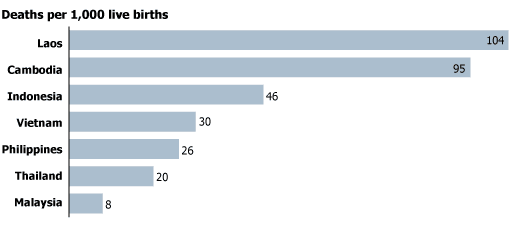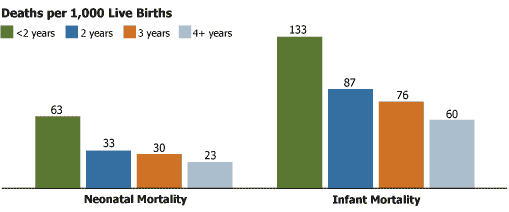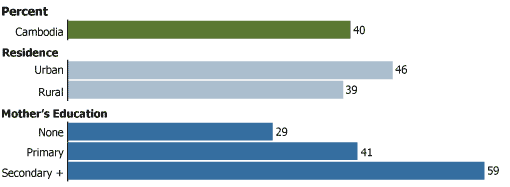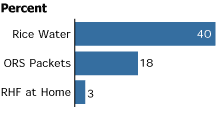
Children in Cambodia Face High Mortality Rate
(December 2002) Despite major gains in child survival in the last 25 years, more than 10 million children around the world die each year before age 5, often from diseases and conditions that are preventable or easily treated. In some countries, more than 1 in 5 children dies before his or her fifth birthday. Many of those who survive childhood illnesses are unable to grow and develop to their full potential. In Cambodia, 1 in 8 children dies before his or her fifth birthday, and many suffer from diseases that are easily preventable through immunization, better nutrition, and proper sanitation.1 Effective programs to prevent and manage major illnesses in children promote healthy growth and development. Continued efforts to provide quality care will require an integrated approach, focusing on both preventive and curative elements to be implemented by families and communities, as well as by health facilities.
Early Childhood Mortality Rates
According to the 2000 Cambodia Demographic and Health Survey (CDHS), for every 1,000 babies born in Cambodia, 95 die in their first year, leading to one of the highest infant mortality rates in Southeast Asia (see Figure 1). Sadly, more than a third of these deaths occur in the first month of life. Another 33 children out of 1,000 die before their fifth birthdays. All together, 1 in 8 Cambodian children dies between birth and age 5.
Figure 1
Infant Mortality in Southeast Asia

Source: PRB, 2002 World Population Data Sheet.
Rural children, those born to mothers with no education, and those whose mothers did not receive assistance at delivery face even higher risks of death. Geographic disparities in child survival are also significant in Cambodia: Infant mortality is highest in Mondol Kiri/Rotanak Kiri (170 deaths per 1,00 live births) and lowest in Phnom Penh (38 deaths per 1,000 live births).2
Maternal Nutrition
Maternal nutrition problems such as anemia and malnutrition not only undermine the health of mothers, but also influence child health. Sixty-six percent of pregnant women in Cambodia are anemic. When mothers are sick or malnourished, their babies face a higher risk of disease and premature death.
Babies born to malnourished mothers are more likely to be too small (underweight). Babies born underweight die at significantly higher rates than those of normal weight and are at greater risk of infection, malnutrition, and long-term disabilities, including visual and hearing impairments, learning disabilities, and mental retardation. As actual birth weights were unavailable for most children, the 2000 CDHS asked mothers to estimate whether their children were born large, larger than average, average, smaller than average, or small. Children reported by their mothers to be smaller than average or small were two and one-half times more likely to have died before the age of 1 month than those reported to be average or larger.3
Birth Spacing
The timing of births has a powerful impact on child survival. Close spacing of births can harm infant health by forcing children to compete for nourishment and care. Children born close together have higher rates of malnutrition, develop more slowly, and are at increased risk of contracting and dying from childhood infectious diseases. In Cambodia, children born within two years of a preceding birth are almost three times (2.8) as likely to die within the first month of life (neonatal mortality) and more than twice (2.2) as likely to die in the first year of life (infant mortality) as children born after at least a four-year interval (see Figure 2).
Figure 2
Childhood Mortality in Cambodia by Birth Interval

Source: 2000 Cambodia Demographic and Health Survey.
Immunization
Childhood immunization against the six standard vaccine-preventable diseases — polio, diphtheria, whooping cough (pertussis), tetanus, measles, and tuberculosis — has the potential to save an estimated 2.5 million children in developing countries every year. Immunization constitutes one of the most cost-effective health interventions. The World Health Organization (WHO) estimates that for every US$1 spent on vaccines, US$29 is saved in treatment and other costs.5 Despite the proven benefits of immunization, coverage in Cambodia remains low — only 40 percent of children are fully immunized against the above diseases.
Children in urban areas and those whose mothers attended at least secondary school are most likely to be fully immunized (see Figure 3). There are also significant variations by province. The proportion of children fully immunized ranges from a low of 12 percent in Kaoh Kong to a high of 63 percent in Bat Dambang/Krong Pailin.6
Figure 3
Full Immunization in Cambodia, Children Ages 12 Months to 23 Months

Source: 2000 Cambodia Demographic and Health Survey.
Childhood Illnesses
Three illnesses — malaria, diarrheal disease, and acute respiratory infection (ARI) — account for most of childhood morbidity and mortality. Diarrhea and ARI cause 80 percent to 90 percent of all deaths from communicable diseases in children under age 5 worldwide. Malaria causes more than 300 million episodes of acute illness and at least 1 million deaths annually in people of all ages. In Cambodia, children are frequently affected by these diseases.
Diarrhea
In the CDHS, mothers reported that 19 percent of their children under 5 suffered from water diarrhea, and 5 percent from diarrhea with blood, in the two weeks preceding the survey. Young children ages 6 months to 23 months are more prone to diarrhea than children in other age groups. Dehydration as a result of diarrhea is a frequent cause of death in young children.
Many of these deaths could be prevented with oral rehydration therapy (ORT), in which the child is given a commercial or homemade water, sugar, and salt solution. The majority of children with diarrhea (61 percent) were treated with some kind of ORT, mainly homemade rice water (see Figure 4). Other treatments included increased fluids, pills or syrups, injections, or home remedies. Twelve percent of children with diarrhea did not receive any treatment.7 Efforts to control diarrhea in Cambodia must be both preventive and curative, based on multiple interventions including the promotion of breastfeeding, adequate complementary feeding, safe water supply, and safe sewage disposal, as well as ORT.
Figure 4
Oral Rehydration Therapy for Children Under Age 5 With Diarrhea, in Cambodia

Source: 2000 Cambodia Demographic and Health Survey.
Fever
The prevalence of fever is a primary manifestation of malaria and other acute infections in children. In Cambodia, mothers reported that 35 percent of their children under age 5 were ill with fever in the two weeks preceding the survey. Children ages 6 months to 23 months are more commonly sick with fever than children in other age groups. There is little variation in prevalence of fever by mothers’ education, residence, or sex of the child. Yet regional variations are marked, ranging from 4 percent of children in Prey Veang to 54 percent in Kampong Chhnang.
Of children who received treatment for their fever, 84 percent received pills (including antimalarial tablets) or syrup (see Figure 5). About 1 in 6 children received intravenous drip or injections, reflecting the severity of the illness. Seven percent received home remedies or other treatment for fever, and 1 in 10 children did not receive any treatment.8
Figure 5
Treatment of Children Under Age 5 With Fever, in Cambodia

Source: 2000 Cambodia Demographic and Health Survey.
Acute Respiratory Infection
ARI is a leading cause of mortality in young children, killing nearly 2 million children under age 5 in developing countries each year. According to the World Bank, ARIs account for between 30 percent and 50 percent of visits by children to health facilities and between 20 percent and 40 percent of children’s hospitalizations worldwide.9 Mothers reported that 20 percent of children under age 5 showed symptoms of ARI in the two weeks preceding the CDHS. In Cambodia, ARI prevalence varies by the age of the child. Children ages 6 months to 11 months are at greatest risk of developing ARI symptoms (27 percent) compared with other age groups. There are no differences in ARI prevalence by the sex of the child, mothers’ education, or place of residence. Regional variations persist: Prey Veaeng has the lowest (3 percent) and Kandal has the highest (32 percent) ARI prevalence among children under age 5.10
Interventions to treat ARI need not be expensive and can be administered at the local level. The U.S. Agency for International Development (USAID) estimates that simple ARI treatment with oral antibiotics, at a cost of 25 cents per dose, can be delivered at the community level to resolve most infant and childhood pneumonias.11
Policy Implications
Programs to help children survive and lead healthier lives are straightforward and highly effective: birth spacing, immunization, nutrition, and sanitation. The economic benefits of such investments are well-documented, showing large-scale returns on investment in health and education and future savings on costs such as health care, remedial education, unemployment, and crime. Investing in children is investing in the future: Today’s children will be tomorrow’s educators, doctors, mothers, fathers, and leaders. Ensuring a healthy entry into adolescence and adulthood is fundamental to sustained development and prosperity in Cambodia.
References
- National Institute of Statistics (NIS), Directorate General for Health [Cambodia] and ORC Macro, Cambodia Demographic and Health Survey (CDHS) 2000 (Phnom Penh, Cambodia, and Calverton, Maryland: NIS Directorate General for Health and ORC Macro, 2001): 121.
- NIS, Directorate General for Health [Cambodia] and ORC Macro, CDHS 2000: 125.
- NIS, Directorate General for Health [Cambodia] and ORC Macro, CDHS 2000: 126.
- NIS, Directorate General for Health [Cambodia] and ORC Macro, CDHS 2000: 127.
- Global Alliance for Vaccines and Immunizations, The Impact of Immunization on Economic Development, accessed online at www.vaccinealliance.org/press/press_econ.html, on July 23, 2002.
- NIS, Directorate General for Health [Cambodia] and ORC Macro, CDHS 2000: 153.
- NIS, Directorate General for Health [Cambodia] and ORC Macro, CDHS 2000: 161.
- NIS, Directorate General for Health [Cambodia] and ORC Macro, CDHS 2000: 155-57.
- U.S. Agency for International Development (USAID), Global Health, Child Survival, accessed online at www.usaid.gov/pop_health/
cs/csari.htm, July 20, 2002. - NIS, Directorate General for Health [Cambodia] and ORC Macro, CDHS 2000: 155.
- USAID, Global Health, Child Survival.
For More Information
Please contact the Department of Planning and Health Information, Ministry of Health, #151-153, Blvd Kampuchea Krom Ave., Phnom Penh, Cambodia
Tel: (855 23) 425 368
